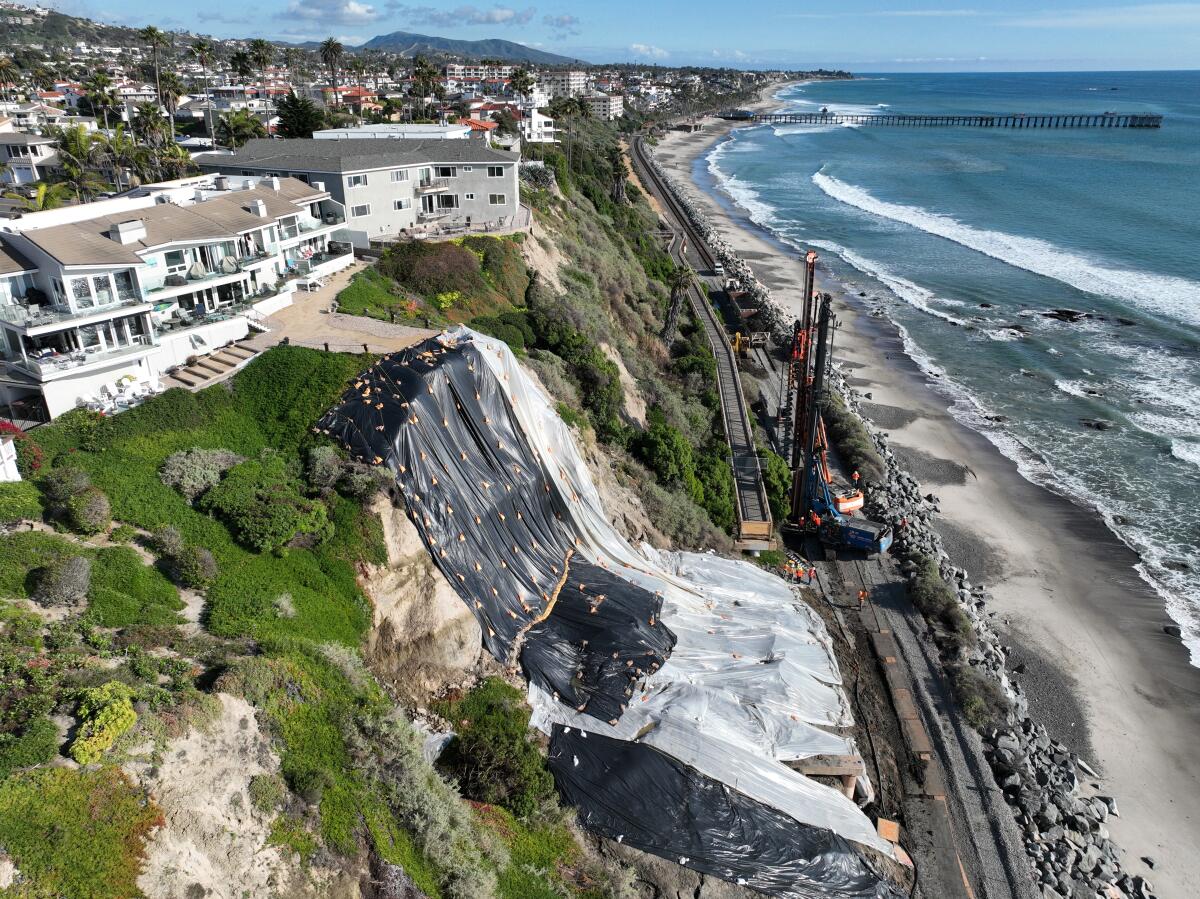[ad_1]
Construction began this week on a barrier wall to shield train tracks from a coastal landslide in San Clemente that has halted passenger train movement between Orange and San Diego counties for more than a month.
The effects of erosion in the area have dogged the region for years, but the problem has become more urgent in recent months amid powerful winter storms that have saturated the hillside, causing it to slide and crumble toward the train tracks below. The landslide has intermittently forced a key segment of the 351-mile coastal rail corridor known as Lossan, which runs between San Luis Obispo, Los Angeles and San Diego, to shut down.
But officials hope the construction of a catchment wall at Mariposa Point, where a pedestrian bridge was destroyed in the landslide roughly a month ago, will help shore up the hillside temporarily and prevent soil from making its way onto the tracks.
The state issued an emergency declaration for the landslide area in early February, allowing local transportation officials to access up to $10 million in funding to protect the tracks and restore rail service. The wall is expected to cost more than $7 million, according to transportation officials.
“The wall itself is the most recent in a series of emergency responses,” said Scott Johnson, a spokesperson for Metrolink. “This wall is really meant to serve as a barrier or a protection for the [coastal tracks] from that privately owned hillside that has been subject to movement and soil and debris falling onto the tracks.”

Crews work on Tuesday to construct a barrier wall at the base of a slope where a landslide occurred in San Clemente. Passenger rail service has been suspended for more than a month.
(Allen J. Schaben / Los Angeles Times)
On Tuesday, two large rigs began drilling holes for the steel beams that will serve as the foundation for the wall. The wall, which will be between 10 and 15 feet high and 192 feet long, will be similar to the one constructed last year below the Casa Romantica Cultural Center and Gardens.
Officials hope to resume passenger rail service by early April after the wall is built and any necessary track repairs — stemming from damage during construction — are completed. The construction site hemmed in by large boulders, rocks and the ocean on one side and a steep incline on the other. There’s only about 100 feet of flat space for crews to work, Johnson said.
“That construction site is so constricted that it’s very challenging to get equipment in there,” he said. “So as these large drill rigs come in and other heavy rail equipment, we anticipate some level of damage [to the tracks]. It’s just a reality of what’s occurring down there.”
Freight trains, which have been able to use the railway intermittently, were halted last week because of the accumulation of soil near the tracks. Transportation officials say they have been warned by geologists not to remove large amounts of soil because it could cause more hillside instability.
This is the fifth time in three years that train service has been interrupted by erosion in the area, and officials are still considering plans to improve movement across the rail system. The Orange County Transportation Authority has launched two studies — one to evaluate strategies to stabilize the hillside to protect rail service for the next 30 years, and another, longer term plan to potentially move the tracks further inland.

An aerial view of a landslide near cliff-top homes where protective tarping was placed to prevent further slides from upcoming rain storms.
(Allen J. Schaben / Los Angeles Times)
Rep. Mike Levin, a Democrat whose district includes portions of south Orange County, told The Times last year that the tracks in San Clemente were one of the weakest links in the rail line, which serves about 4 million passengers annually, down from more than 8 million before the COVID-19 pandemic.
“Rather than putting Band-Aids on this every year, I want to think long-term about how we ensure the rail corridor is up and running for decades and centuries to come,” he said at the time.
[ad_2]
Source link




















